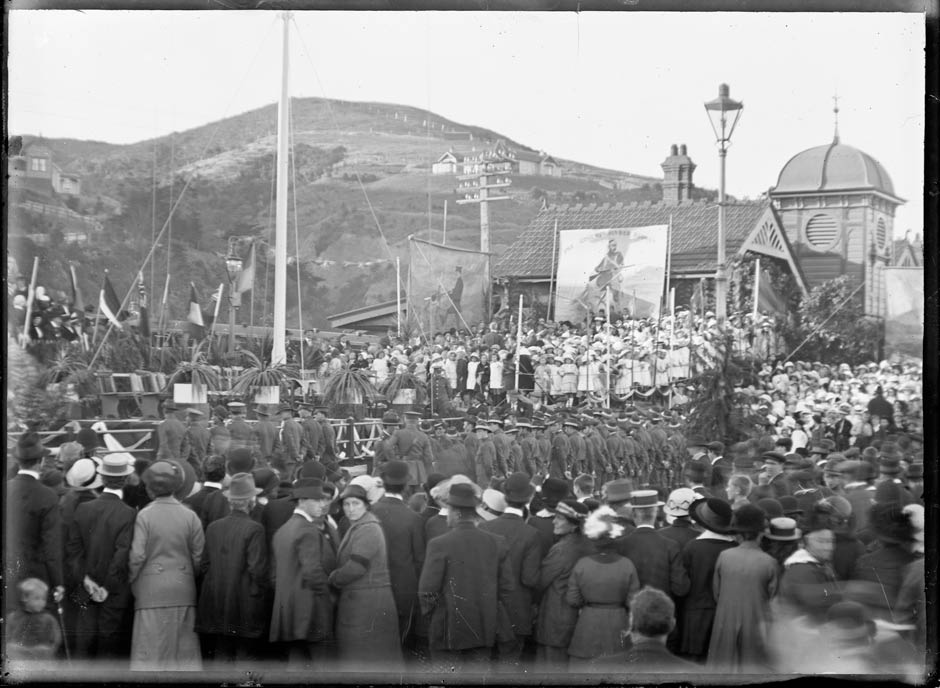
A large crowd gathers by the flagpole outside the Petone railway station and workshops during Anzac Day commemorations in 1916.
On the first anniversary of the Gallipoli landings, 25 April 1916, a commemorative flagpole made from kauri and Australian hardwood – symbolising ‘the unity of Australian and New Zealand railwaymen in peace and war’ – was unveiled outside the Petone railway station and workshops. Railway workers at Hornsby in New South Wales had proposed that railwaymen on each side of the Tasman exchange their national flags to honour the Anzac connection.
By this time it was said that up to 2000 New Zealand Railways employees had enlisted and at least 37 had lost their lives. Prominent among them was Major Norman Frederick Hastings, a 36-year-old fitter and foreman at the Petone workshops who had served in the South African War. Hastings assumed command of the 6th (Manawatu) Squadron of the Wellington Mounted Rifles Regiment during the August offensive at Gallipoli and died of wounds received on 9 August 1915 during the battle for Chunuk Bair. He was posthumously awarded the DSO and appointed a Chevalier de la Légion d'Honneur (France) for his outstanding leadership. It is thought that his workmates' desire to acknowledge his death was another key motivation for the erection of the Petone memorial.
The large banner in the centre of the scene depicts a soldier and carries the words, ‘The absent minded beggar’, referring to an 1899 poem by Rudyard Kipling which was set to music by Sir Arthur Sullivan and used as a patriotic fundraising song during the South African War.
See another image of this memorial unveiling.
In the years following the unveiling of the flagstaff, Petone workshop staff lowered the flag whenever they learned that one of their workmates had died. Their colleagues at the East Town Railway Workshop in Whanganui held similar ceremonies.
The workshops and station building have since been demolished; the flagpole was partially restored in 1995 and refurbished in 2004.
Petone railway station memorial today
On Anzac Day 2016 a ceremony was held at Petone railway station to mark the centenary of the 1916 event. In addition to speeches, the laying of wreaths and the raising of an Australian red ensign (as in 1916), a replica wooden roll of honour board was unveiled in the railway station. This listed the names of 10 employees of the Petone workshops who lost their lives in the First World War, and replaced a similar board which was lost in the early 2000s. Following the early-morning ceremony, the restored steam locomotive Passchendaele (AB 608) hauled a train of First World War-era carriages on excursion trips between Wellington, Petone and Taita stations (and later in the afternoon, between Wellington and Paekākāriki).
The Petone Anzac Day centenary programme, which was organised by the rail operator KiwiRail, supported by the Rail Heritage Trust, the Rail and Maritime Transport Union, local authorities, the RNZRSA and Steam Incorporated, also featured the publication of a booklet, New Zealand railwaymen at war 1914-18. An historic film trailer was shown at the Light House cinemas in Petone, Pāuatahanui and Wellington in the weeks before Anzac Day.








Community contributions